 |
 |
|
UER Store
|
|
 order your copy of Access All Areas today!
order your copy of Access All Areas today!
|
|
 |
 Roadwolf
         
The Wolf!
Location: Buffalo, NY (formerly Toronto, Canada)
Gender: Male

Living on the Road and Rails.
 | |  | |  | |  | RF Towers, and Roof Tops
< on 6/20/2005 5:53 PM >
|  | | | Some of us like to explore rooftops and areas which include alot of communications towers. And I know that some of the people on this site know a bit about RF Radiation and can add some useful information to this thread. However I think that a thread about this, to advise new explorers of the dangers of RF Radiation is a good idea.
High level RF (or Radio Frequency) Radiation is more dangerous then you may think.
Lets start with AM Broadcast sites: AM Radio was very popular at one time, and there are many abandoned AM Tower sites... However there are many active AM Broadcast sites aswell. This is a picture of an Abandoned AM Site...
Not much to see... Transmitters are expensive and are usually sold off...
However Active sites may look abandoned... it is hard to tell sometimes because lower budget radio stations may not spend the money to upkeep their transmitter.
AM Towers have to be fenced in as per Safety Code 6 requirements. No matter where they are or how accessable they are, because the whole tower is energized with RF.
This is a picture of a couple AM Transmitter towers:

AM Towers are usually always multi-tower arrays. And you will generally not see any other antennas on AM Towers... the towers are usually just straight towers with nothing but warning lights attached to them. However sometimes there will be an "STL" Antenna (Studio - Transmitter Link) Attached to the tower which might look like this:
 Typical STL Antenna Install on an AM Tower. The guy standing there is a professional tower climber. In order to get onto a AM Tower without being zapped, you basically have to jump onto it without touching the ground. And when you are on the tower, there is a potential for you to hit a "hot spot" where the RF is so strong that you can not hold on to the tower. Typical STL Antenna Install on an AM Tower. The guy standing there is a professional tower climber. In order to get onto a AM Tower without being zapped, you basically have to jump onto it without touching the ground. And when you are on the tower, there is a potential for you to hit a "hot spot" where the RF is so strong that you can not hold on to the tower.
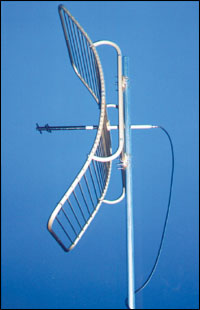 Typical UHF STL Antenna up close. Typical UHF STL Antenna up close.
AM Towers, as mentioned before are also completely energized. This picture shows how an AM Tower is insulated from the ground by an insulator...
As you can see, the tower is completely being supported by this brown insulator. The rods with the metal balls are actually spark gaps for lightning protection.
The voltage on an AM Tower is usually a couple thousand volts. It really depends on the transmitter and the actual transmission. But the amperage of the towers can be pretty high - the towers I work on are usually around 30 or 31 amps at 6000 volts.
I was talking to someone I work with, and he actually got zapped by some RF a long time ago while working on a Transmitter hut... which is basically a room at the base of the tower filled with coils and such, which are all wide open and unprotected. I couldn't find a good picture of these coils inside a room.. but here is a picture of them inside a small cabinet.
Anyhow, basically he was sweeping the floor and his shoulder brushed against a live coil. his skin started to melt instantly... he said his skin actually liquified and he had to stand still while it re-solidified... so basically RF Can Melt You !!!
FM Broadcast Sites:
FM Sites are generally safer for those walking around on the ground. As the antennas are usually higher up at the top of a tower... Here is a picture of your average FM Broadcast tower install...
Some may be slightly more complex... such as:
or others may be much cleaner...

Either way... An FM Site generally only consists of ONE Tower, which has several antennas on it. They range in power from as low as 500 Watts... (or lower) to upwards of 100,000 Watts or higher in some cases. But are generally around 20,000 Watts which is enough to cover a city the size of the Greater Toronto Area.
Often 2 or more FM Stations will use one set of antennas... and in this case there will be a Combiner room where each stations transmitter feeds into tuneing chambers and filters and gets combined into one single RF Transmission line.
It is possiable for FM Broadcast band RF Radiation to harm people who are close to the antennas. Usually a sign of a high RF Feild is a headache or migrane, called a RF Headache, which will go away when you exit the RF Feild. However usually once you are in that feild you have already done damage and the RF can cause you to be impotent quite quickly depending on the level of RF. I know people who have been working in RF for a long time, and they were impotent within a year of working with RF... so it can happen quite fast, all you need is that one blast of high power RF to do it!
Low Frequency Stuff:
Large arrays and sites are fairly common in the VLF LF MF and HF bands... However, they are few and far between. they are generally used for long range communications (Amature Radio), Marine Radio, and Aeronautical (Navigation Radio), Broadcast (AM Radio), and Military stuff... Some pics...
Here is a pic of a HAM's (Amature Radio Operator) home setup of MF and HF antennas... on his roof !
I would probably say your generally safe walking around in low frequency feilds. however dont go near any antennas as they might be energized.
VHF and UHF Communication sites:
Commercial Communications sites are quite common... Here are some pictures...
This is your average VHF Base Tower... VHF is commonly used for communication in more rural areas and is being generally phased out in urban centers. Things like the Fire Dept, Police, Works Dept, Trains, Marine, Public Transportation, and Taxis commonly use VHF Communications. VHF is the prefired method for long range coverage for communications over a wide area... as it tends to pass thru trees and small hills easier then UHF Communications.
VHF Towers for communications usually only operate up to 500 Watts...
VHF Towers generally don't need to be very powerful because of the ability to pass thru small hills and terrain easier then other forms of communication. However don't be fooled, VHF Communications, if powerful enough can still give you headaches and cause you harm if your close enough.
UHF Sites are far more common in urban centers... here is a picture of a UHF Antenna
Usually they look like this... these are common antennas called folded di-poles. Used for both VHF and UHF... they are very common, the difference between this one and the VHF one is that UHF folded Dipoles are smaller, about half the size of the VHF folded Dipoles.
There are also directional antennas... such as this one...
 38685.jpg (39 kb, 407x305) 38685.jpg (39 kb, 407x305)
which is a home made UHF Yagi antenna... I tried to find a pic of one on a tower but was too lazy too look very hard.
UHF-Lo is usually used for federal communication (FBI, RCMP), Transit, and Commercial stuff.
Same rules apply for UHF-Lo as they do for VHF, in terms of safety... dont touch the antennas - and don't stand infront of antennas... they usually aren't too powerful. and if they are, they will usually warn you.
UHF-Hi sites are pretty common now... This is the band that alot of cell towers operate at. Other users include police, fire, municipal, and commercial.
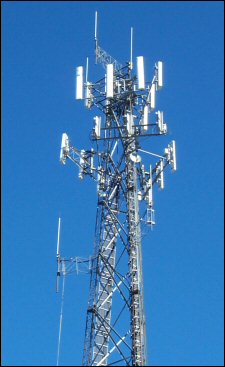
This is a Cell phone tower, as well as a LTR Trunking tower for 800 MHz trunking and cell systems. they are fairly safe on the ground, however I would not advise going up and climbing up near the antennas... not a good idea if you want to have children one day.
TV Stations:
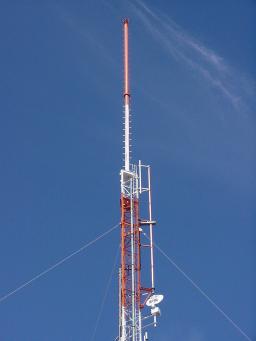
This is a VHF D-TV Antenna.
This is a VHF TV Antenna
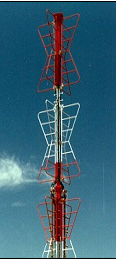
And this is a UHF D-TV Antenna
TV sites are usually quite powerful and they also usually have Microwave STL equipment which can be dangerous. Try and stay well away from TV sites.
Microwave ground to ground link sites:
Microwave links are actually quite common. Here are a few pics...
Those drums are microwave antennas... standing directly infront of it would not be advisable as they will probably harm you. however because they are so high up usually, you are normally fine around towers that have them. However if your on a roof and you are near one, I wouldn't stay there long.
Here is a picture of a newer type of Microwave Link...

Anyhow, stay away from the front of these antennas...
Microwave ground to space links:
You have seen these. regular dishes... I would tend not to hang around them, as you dont know the power of the dish. some may be quite powerful, however usually they don't require alot of power to shoot into space. no more then 50 watts atleast. but at a microwave frequency that can do damage.
Radars:
Wheather it be for weather, airplanes, or boats... radars are generally pretty dangerous to stand beside if they are operating. they are quite powerful, so much so that you can sometimes hear them pulsing on radio bands far away from the band at which the radar is tuned for.
I would generally advise you to stay well away from a radar site.
Safety Code 6:
Safety Code 6 in Canada is what protects us (the general public) from harmful RF Radiation. It requires companies to warn the general public where a dangerous RF feild is present and usually requires fencing around dangerous areas. In most cases you will not be able to enter a dangerous RF Zone without first atleast passing a sign stating its dangerous... This code even requires the company to fence off areas in which the RF level is above a certian point. for AM Broadcast stuff that is at 60 volts per meter... They even have to do this if there is already a fence around the property.
Anyhow, I hope that this has been useful.. and I hope others can add to it. I spent a fair bit of time on it 
[last edit 6/20/2005 6:38 PM by Roadwolf - edited 2 times]
Add me on Skype or Steam: Roadwolf611
|
|
grit1
 
Location: University Campus - Minneapolis, MN
Gender: Male

Got Shear Line?
 | |  | |  | Re: RF Towers, and Roof Tops
<Reply # 1 on 6/20/2005 7:47 PM >
|  | | | Nicely compiled, good pics ... thanks for the info, I've always been interested in communications towers and this post answered some questions. Nice job. ~Grit.
|
|
drainpunk
 
 | |  | Re: RF Towers, and Roof Tops
<Reply # 2 on 6/20/2005 8:23 PM >
|  | | | Hey, thanks a bunch dude!
I haven't climbed these kind of things yet, but I've been planning to. But now when I read this, I'm not so sure anymore.. I seriously had no idea they could be dangerous! This thread probably saved my life. Seriously. This also taught me I should read more about stuff I haven't yet visited (in other words, this kind of towers).
However, I'm still going to climb to roofs.. So, here's one question: There's some local, technical university that is one of the biggest in this country. There's allkinds of technic on the roofs, including dishes. Too bad I don't have any picture that I could show right now.. I could've taken a picture although I haven't been very near those yet. So, you said:
| You have seen these. regular dishes... I would tend not to hang around them, as you dont know the power of the dish. some may be quite powerful, however usually they don't require alot of power to shoot into space. no more then 50 watts atleast. but at a microwave frequency that can do damage. |
Some of those dishes are much bigger than regular dishes (not to mention I don't know if there's some other dangerous stuff). What is the safe distance, roughly? Couple of meters, ten meters or twenty meters or more?
I'll keep distance to that stuff, as well as try to stay from microwave frequency's path. 
|
|
nostra-YOUPPI!
   
Umpire
Location: Shahre:'on Kaybec

Bonsoir et cest partie
 | |  | Re: RF Towers, and Roof Tops
<Reply # 3 on 6/20/2005 9:58 PM >
|  | | | in montreal there are a lot of old transmitters sitting although in the last 5 years we lost CFOX and CKVL former sites, the old CBC towers (an unequal height pair) are now broadcasting a tone high up on the dial and the old ckgm Great 98 towers all but 2 came down in the ice storm, now they re built 1 they use two of 3 towers on the site the 3rd tower is still dangerous because of induction
Montreal Expos 1969-2004 Forever Proud Lets Keep The Dream Alive |
|
Random
  
Location: Richmond, Virginia
Gender: Male

Partially Retired
 | |  | |  | Re: RF Towers, and Roof Tops
<Reply # 4 on 6/20/2005 10:21 PM >
|  | | | Thank you VERY much! I'd been meaning to ask about this. There are several cell phone towers hidden in the back of a local park that closes at dark. I was thinking about climbing them, not anymore.
|
|
Explorer Zero
     
 | |  | |  | Re: RF Towers, and Roof Tops
<Reply # 5 on 6/20/2005 10:41 PM >
|  | | | Excellent tutorial on antennae.
Theres still a few old abandoned AM stations around Dallas, one KSKY has actually been resurrected and back on the air now!
Just got through posting a UE DB location "The Satellite Corporation" once a Navy earth station with a couple different towers and dishes. Maybe a COMSAT or Inmarsat station in the 70s. Maybe a cellphone lift or something now.
Those covers on the mw dishes they call snow domes btw are really buzzard domes in Texas (having more buzzards than snow :)
|
|
Caveman6666
     
Location: NY
 | |  | |  | Re: RF Towers, and Roof Tops
<Reply # 6 on 6/21/2005 2:26 AM >
|  | | | Good info.
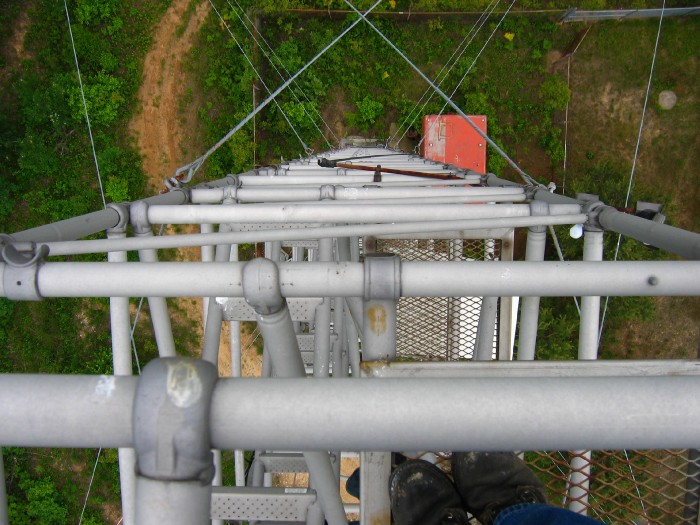
Yet another unoriginal generic UE website. GODDAM! |
|
Barry Kooda
    
Location: The Cliff
Gender: Male
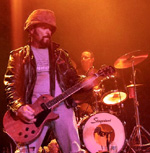
Trees
 | |  | |  | Re: RF Towers, and Roof Tops
<Reply # 7 on 6/21/2005 3:02 AM >
|  | | | I get enough climbing at work.
Me and Rod VanEgmund at the Gaylord Hotel
I'm a blatant waste of time and resources. |
|
Robz

 | |  | Re: RF Towers, and Roof Tops
<Reply # 8 on 6/21/2005 6:23 PM >
|  | | | Posted by Roadwolf
Microwave ground to space links:
You have seen these. regular dishes... I would tend not to hang around them, as you dont know the power of the dish. some may be quite powerful, however usually they don't require alot of power to shoot into space. no more then 50 watts atleast. but at a microwave frequency that can do damage.
|
just an extra safety note...never go inside base buildings or surrounding buildings that house these dishes...as you will suffer a horrible death if its turned on, and if you do go into one, make sure you have one of the fuses/switches/ other name that i cant remember, with you to make sure it cant be turned on with you inside 
|
|
ArmchairExplorer
 
Location: Vancouver

 | |  | Re: RF Towers, and Roof Tops
<Reply # 9 on 6/21/2005 8:21 PM >
|  | | | Posted by drainpunk
What is the safe distance, roughly? Couple of meters, ten meters or twenty meters or more? |
Dishes and other directional antennas can put out some serious power along their pointing axis. The danger zone could be could be a hundred meters or more.
|
|
NoSuchPerson
      
Stop, or I'll ask you again!
 | |  | Re: RF Towers, and Roof Tops
<Reply # 10 on 6/21/2005 9:25 PM >
|  | | | First, to nitpick.
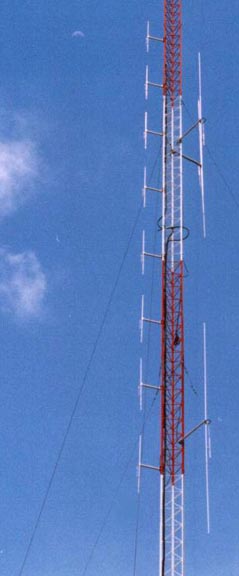
That's not an FM Broadcast array. It's a Sinclabs SRL201 VHF commercial antenna array for 2-way radio. I have one sitting next to me.
Secondly,  isn't an LF antenna. It's a DME (Distance Measuring Equipment) for an airport. It transmits a continuous signal with CW (morse code) from an airport. For example, the one at Pearson transmits on 110.400 and transmits "B" over and over again in CW. isn't an LF antenna. It's a DME (Distance Measuring Equipment) for an airport. It transmits a continuous signal with CW (morse code) from an airport. For example, the one at Pearson transmits on 110.400 and transmits "B" over and over again in CW.
A REAL LF antenna looks like this:

It's size depends on frequency, but for LF (less than 1MHz), the length "L" would be about 800 feet. So they're VERY big antennas.
-Ex
[last edit 6/21/2005 9:36 PM by NoSuchPerson - edited 3 times]
Unit calling radio say again? |
|
drainpunk
 
 | |  | Re: RF Towers, and Roof Tops
<Reply # 11 on 6/21/2005 9:58 PM >
|  | | | | Dishes and other directional antennas can put out some serious power along their pointing axis. The danger zone could be could be a hundred meters or more. |
Sh*t.. Gotta be extra careful.. Approaching from the direction they are not pointing is safe(r)..?
|
|
NoSuchPerson
      
Stop, or I'll ask you again!
 | |  | Re: RF Towers, and Roof Tops
<Reply # 12 on 6/21/2005 11:46 PM >
|  | | | Yes. That is correct.
In the US, when the Military started testing Radar back in the day, they couldn't figure out why most of the RF guys went sterile, got various cancers, etc... It's because they would stand 3 feet from a 200kW dish...
-Ex
Unit calling radio say again? |
|
Roadwolf
         
The Wolf!
Location: Buffalo, NY (formerly Toronto, Canada)
Gender: Male

Living on the Road and Rails.
 | |  | |  | |  | Re: RF Towers, and Roof Tops
<Reply # 13 on 6/22/2005 12:04 PM >
|  | | | Posted by ExKa|iBuR
First, to nitpick.

That's not an FM Broadcast array. It's a Sinclabs SRL201 VHF commercial antenna array for 2-way radio. I have one sitting next to me.
|
Yea I kinda thought it was lacking, but it was on a FM Radio stations website showing pics of their antenna and stuff... I guess they are being cheap.
Secondly,  isn't an LF antenna. It's a DME (Distance Measuring Equipment) for an airport. It transmits a continuous signal with CW (morse code) from an airport. For example, the one at Pearson transmits on 110.400 and transmits "B" over and over again in CW. isn't an LF antenna. It's a DME (Distance Measuring Equipment) for an airport. It transmits a continuous signal with CW (morse code) from an airport. For example, the one at Pearson transmits on 110.400 and transmits "B" over and over again in CW.
A REAL LF antenna looks like this:

It's size depends on frequency, but for LF (less than 1MHz), the length "L" would be about 800 feet. So they're VERY big antennas.
-Ex
|
yea I couldn't find a good pic of a low freq antenna... however that one did come up in a search for some reason.
Add me on Skype or Steam: Roadwolf611
|
|
nostra-YOUPPI!
   
Umpire
Location: Shahre:'on Kaybec

Bonsoir et cest partie
 | |  | Re: RF Towers, and Roof Tops
<Reply # 14 on 6/22/2005 12:26 PM >
|  | | | i was doing some work for a company who was next to standstill broadcastings AM station in montreals transmitter, the signal off the transmitter kept our flourescent lights somewhat lit all the time
Montreal Expos 1969-2004 Forever Proud Lets Keep The Dream Alive |
|
Louie
      
 | |  | |  | Re: RF Towers, and Roof Tops
<Reply # 15 on 6/23/2005 12:01 AM >
|  | | | So what about just simple RF dipoles found on pretty much any urban rooftop?
|
|
Agent Skelly
       
Web Sheriff
Location: Oregon Territory
Gender: Male
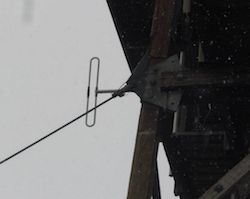
Prenez De L'Avance Avec Chrysler!
 | |  | |  | |  | |  | Re: RF Towers, and Roof Tops
<Reply # 16 on 6/23/2005 12:20 AM >
|  | | | The one FM radio station in Albany, 106.5 I know up at their transmitter site, has their radio shack as a old house they just covered up the windows.
|
|
nostra-YOUPPI!
   
Umpire
Location: Shahre:'on Kaybec

Bonsoir et cest partie
 | |  | Re: RF Towers, and Roof Tops
<Reply # 17 on 6/23/2005 3:08 AM >
|  | | | if you like tower sites i follow fybush.com religiously
Montreal Expos 1969-2004 Forever Proud Lets Keep The Dream Alive |
|
Mickael
      
Moderator
Location: Canada
Gender: Male

 | |  | Re: RF Towers, and Roof Tops
<Reply # 18 on 6/23/2005 6:59 PM >
|  | | |
Any idea about what kind of antenna is this ?
I think it's cell phone related but I'm not sure.
Need forum-related help / Besoin d'aide reliée au forum ? Contact a moderator |
|
NoSuchPerson
      
Stop, or I'll ask you again!
 | |  | Re: RF Towers, and Roof Tops
<Reply # 19 on 6/23/2005 10:23 PM >
|  | | | Yes, those are cell antennas. They look to be 800MHz which could be AMPS (analog), 850 PCS or iDEN (NEXtel). BCT Chronic could speak to exactly what they are, as that's his "baby".
-Ex
Unit calling radio say again? |
|
|
|
All content and images copyright © 2002-2024 UER.CA and respective creators. Graphical Design by Crossfire.
To contact webmaster, or click to email with problems or other questions about this site:
UER CONTACT
View Terms of Service |
View Privacy Policy |
Server colocation provided by Beanfield
This page was generated for you in 172 milliseconds. Since June 23, 2002, a total of 739161619 pages have been generated.
|
|

 order your copy of Access All Areas today!
order your copy of Access All Areas today!






 Typical STL Antenna Install on an AM Tower. The guy standing there is a professional tower climber. In order to get onto a AM Tower without being zapped, you basically have to jump onto it without touching the ground. And when you are on the tower, there is a potential for you to hit a "hot spot" where the RF is so strong that you can not hold on to the tower.
Typical STL Antenna Install on an AM Tower. The guy standing there is a professional tower climber. In order to get onto a AM Tower without being zapped, you basically have to jump onto it without touching the ground. And when you are on the tower, there is a potential for you to hit a "hot spot" where the RF is so strong that you can not hold on to the tower. Typical UHF STL Antenna up close.
Typical UHF STL Antenna up close.







 38685.jpg (39 kb, 407x305)
38685.jpg (39 kb, 407x305)















 isn't an LF antenna. It's a DME (Distance Measuring Equipment) for an airport. It transmits a continuous signal with CW (morse code) from an airport. For example, the one at Pearson transmits on 110.400 and transmits "B" over and over again in CW.
isn't an LF antenna. It's a DME (Distance Measuring Equipment) for an airport. It transmits a continuous signal with CW (morse code) from an airport. For example, the one at Pearson transmits on 110.400 and transmits "B" over and over again in CW.


